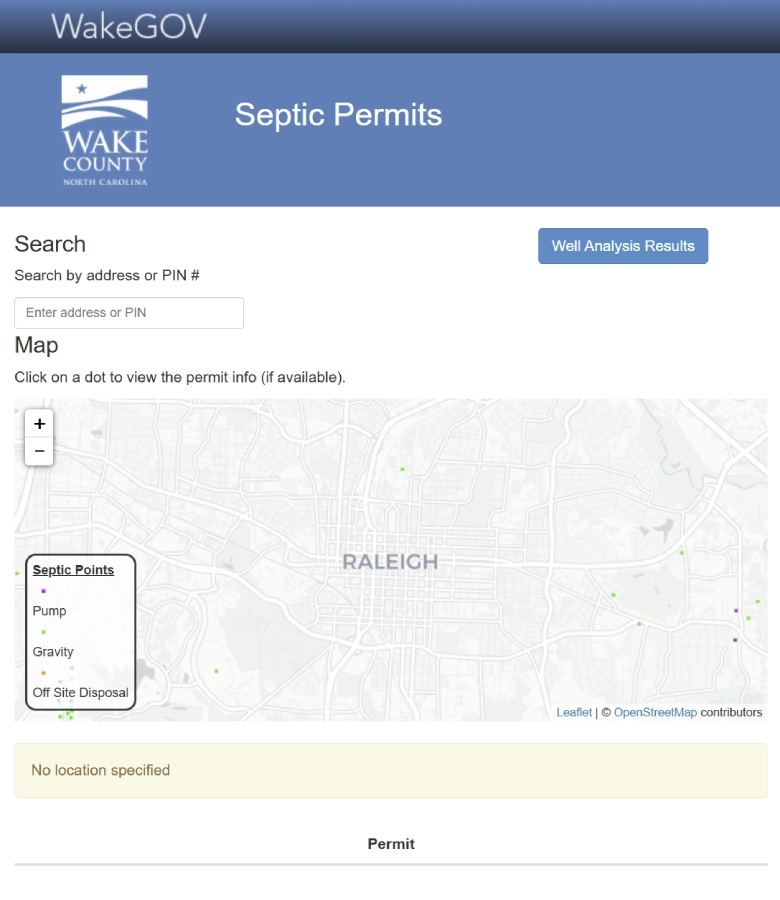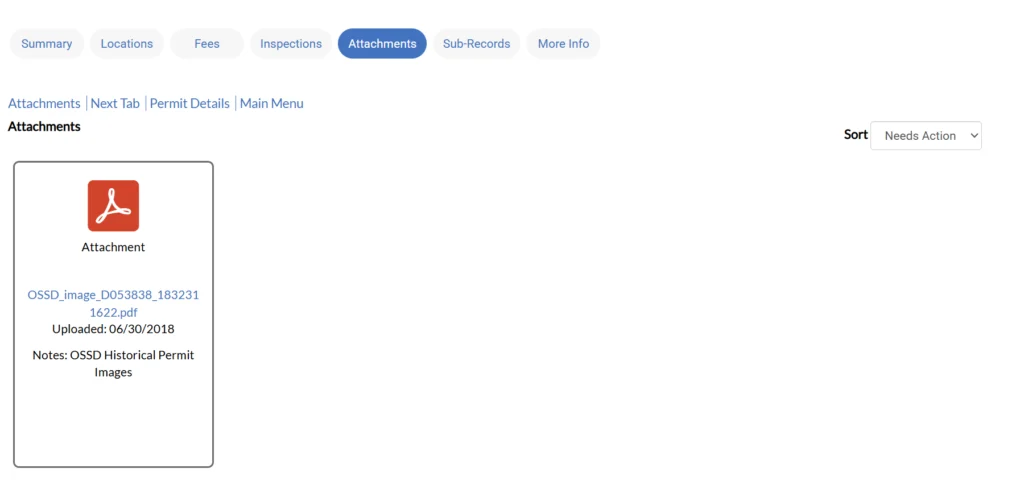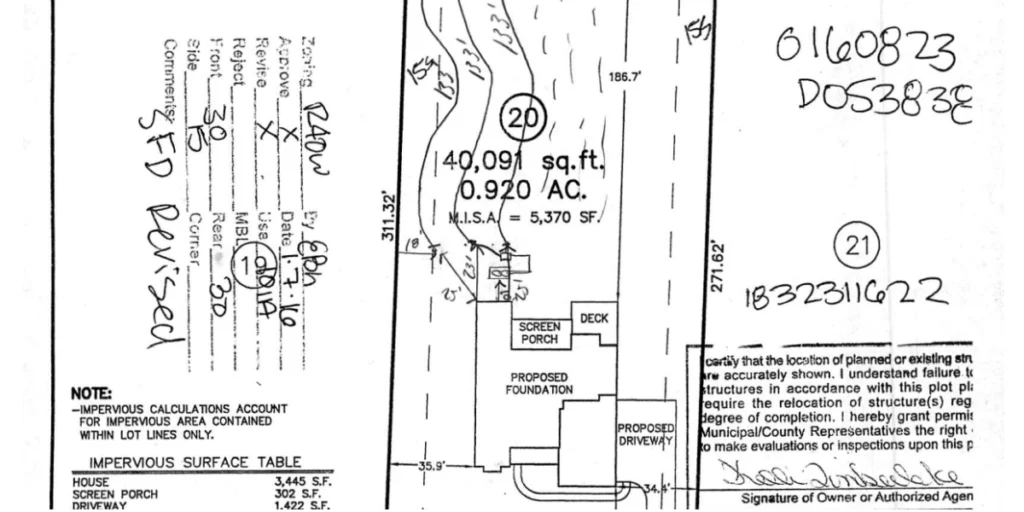How to Find a Septic Permit in Wake County (Step-by-Step with Pictures)
 Raleigh ProConnect
Raleigh ProConnect- March 12, 2025

If you own a home in Wake County, your wastewater is handled in one of two ways: city sewer or a septic system. If you’re in a more rural area, chances are you have a septic system. And if this is your first time owning a home with one, you might not even know exactly where it’s located—but you should.
Why? Because at some point, you’ll need to find it.
Maybe you’re adding a deck, installing a pool, or need a natural gas service line installed to switch over to a gas furnace and need to know where your septic system is so you don’t damage the tank or drain field.
Maybe your septic tank is due for a pump-out, and you want to make sure the crew knows exactly where to go. Or maybe you’re selling your home, and the buyer (or their lender) wants to see records of the system.
Whatever the reason, this guide will walk you through how to find your septic permit online through Wake County’s database—step by step.
And if your septic system isn’t showing up? We’ll cover what to do next.
How to Find a Septic Permit for Your Home in Wake County, NC
Step 1: Go to the Wake County Septic Permit Search Website
Start by visiting Wake County’s Septic Permit Search page: Wake County Septic Permit Search

This is the official database where you can search for septic permits by address. Bookmark this page in case you need to reference it again in the future.
Step 2: Enter Your Address and Select it From the Dropdown
Begin typing your home address in the search bar. Wait for the dropdown list to appear, and make sure to click on your address from the list—this is the only way for the system to recognize it.
If you type in your address and press “Enter,” the search won’t work. This small step trips up a lot of people, so be patient and select your address from the dropdown before moving forward.
The video below shows you how to do this:
Step 3: Click on the Available Permit for Your Address
After selecting your address, if there is a septic permit available, you should see it populate underneath the Permit section at the bottom. This will just be a set of letters and numbers representing your permit number.
Next, you click on the permit link. This will take you to the Wake County Permit Portal, where your septic permit information will be located.
Note: You might see a set of permits once you click on your address. I would recommend starting with the first link and continuing to the next step. If you don’t find what you need with that particular permit, you can always come back and click the other links until you find which one holds your septic drawing.
Step 4. How to Find Your Permit in the Wake County Permit Portal
Once the permit portal has loaded, you will see information about the permit, like the type of permit, when it was applied for, the district, etc.
Underneath this area, you’ll see a set of buttons you can click. These are labeled as Summary, Locations, Fees, Attachments, Sub-Records, and More Info.
Since you are looking for your actual septic permit, you will click on the attachments button.

Step 5. View or Download Your Septic Permit
Once you click on the attachments button, you’ll see a PDF file located underneath if there is a recorded septic permit for your property.
When you click on this PDF, it will ask you to either save it to your device or open it in your browser. This is your septic permit.
As you scroll down the permit, you will eventually get to a page showing a drawing of your septic system and potentially other measurements you can use to determine exactly where your septic tank and drain field are located on your property.


What To Do if Your Septic Drawing is Really Old and Illegibal
If you have an older home or a property with the original septic system still installed, don’t be surprised to see a drawing that closely relates to a cartoon sketch.
Back in the ’70s and ’80s, getting a septic approval from Wake County was easier. Record-keeping wasn’t as detailed as it is today and there wasn’t as many environmental regulations to follow.
In some cases, you’ll see a drawing, but you won’t be able to find any real information to help you understand where your septic system is laid out on your property.
If you run into this issue, your next best option is to hire a local private utility locating company.
Hiring a Private Locating Company
Because septic systems are privately owned, you can’t call 811 to locate them like you would for public utilities. Instead, you’ll need to hire a private locating company.
Locators use different methods to find your septic system. Some will probe your yard with a metal rod, while others might use a more expensive ground penetrative radar system. The locating method depends on your property size and how difficult the system is to locate.
Either way, it can be pretty expensive.
How Much Do Most Private Locating Companies Charge?
On average, you can expect to pay anywhere from $300 to $1,000+ to have your private utilities located by a private locating company. This, of course, depends on the size of your property.
Some companies charge a flat fee per private utility (like septic, well, or electrical), and others mark all your private utilities on your property at once for a bundled price.
The good news is you should only have to get this done once.
Most companies will mark your property with paint or flags and provide you with photos or a drawing outlining where all your private utilities are. Make sure you keep any documents they give you with your home records just in case you need them in the future.
What To Do if You Can't Find Your Septic Permit Online
Sometimes, you won’t be able to find your septic permit online. This could be because:
- Your home doesn’t actually use a septic system
- Your home used to have a septic system, but now it’s tied into the city sewage system
- It hasn’t been uploaded to the permit portal
To help you figure this out, you can contact the Wake County Environmental Health and Services Department.
Contact the Wake County Environmental Health and Services Department for Septic Records
If you can’t find your septic permit online, you can try calling the Wake County Environmental Services Department to check and see if they have a permit filed away somewhere.
If they do, they’ll be able to send you a copy of it in the mail.
If you know your home uses a septic system, and you can’t find a permit online, or you’ve requested a copy of your permit through Wake County Environmental Services, but they don’t have any records of a septic system ever being on your property, you will have to apply for a new septic permit and inspection.
Who Handles Septic Permitting and Inspections
If you live in Wake County’s jurisdiction and your septic system is unrecorded (meaning you can’t find it online, and Wake County doesn’t have a record of it), you’ll need to apply for a Residential Wastewater (Septic) Permit through Wake County’s permit portal.
However, if your property is within city or town limits, you should contact your local planning department first for septic permitting information.
Wake County States: “The requirement for a wastewater review depends on the regulations of the planning jurisdiction where the property is located.”
Here are the cities and towns that have their own planning jurisdiction (separate from Wake County’s direct jurisdiction):
Tip: Use iMaps to check and see which jurisdiction your property falls under. Enter your address under “Property Search” on the top right and click on it when it populates in the dropdown box. Once clicked on, you will see your jurisdiction under the “General” heading.
If you fall under Wake County’s jurisdiction and you need an evaluation, the Environmental Services Department will review your property to make sure there’s enough space for:
- The existing structure
- The current septic system
- Room for repairs if the system fails
If any adjustments need to be made, they will let you know through the permit portal. Keep in mind that a professional engineer might be required to bring your septic system up to code, and you may also have to apply for a building permit or a planning and zoning permit.
One other quick note—if it’s determined a building permit is required and you live in one of the towns listed below, they use the Wake County permit portal for building permits:
- Knightdale
- Rolesville
- Wendell
- Zebulon
What to Know When Sending in Your Wastewater Permit Application to Wake County
If your property has an unrecorded septic system, you will need to apply for a new permit—or at least get a verification for reuse or a change of use so it’s documented properly.
Below is a breakdown of the process, costs, and timelines when applying for a Residential Wastewater (Septic) Permit in Wake County.
How to Apply for a Residential Wastewater (Septic System) Permit Through Wake County's Inspection Portal
- Prepare Your Site Plan:
- Include property boundaries, existing structures, and the septic system location.
- Clear any vegetation or obstacles that might block the inspection.
- Submit Your Application:
- Use Wake County’s Permit Portal to apply for a Residential Wastewater (Septic) Permit.
- Navigate to the “Apply” button on the portal, select “All 66” under permits, and search for “wastewater” or “septic.”
- Pay Invoices: Once your application is submitted, you can pay the required fees through the Permit Portal.
- Inspection and Review: Once your application is sent, Wake County will schedule an on-site review of your property.
Costs and Fees
| Permit Type | Fee | Purpose |
| Verification for Change of Use or System Reuse | $200 | Required to confirm and document an existing septic system if no changes are being made to lot size or wastewater flow |
| Improvement Permit (if required) | $200 | Evaluates soil conditions and system suitability |
| Construction Authorization (if required) | $200 | Includes the Operation Permit, ensuring the system meets regulations |
| Design Review Fee | $110 | This applies if site modifications or additional planning reviews are needed |
| Field Consultation | $100 | Required if an inspector needs to visit the property to assess the system in person |
| Re-Inspection Fee | $75 per visit | Charged for additional site visits due to failed or incomplete inspections |
If your system has never been officially permitted, Wake County might require a full review, which could include:
- Verification Permit ($200)
- Improvement Permit ($200)
- Design Review ($110)
- Construction Authorization ($200)
This brings the estimated cost to $710 for basic permits and reviews before additional fees.
This also assumes your system doesn’t require repairs, additional site visits, or design modifications to bring it up to code. If a re-inspection is needed, expect an additional $75 per visit.
To make sure you’re getting the most accurate and up-to-date information, it’s best to check with Wake County Environmental Services to confirm what’s required for your specific property.
For the most up-to-date fee details, visit Wake County’s Wastewater Fees Page.
What Kind of Timelines to Expect During the Permitting Process
Wake County has a tool that shows the average number of days it takes for an inspector to review your property for the first time and for authorization to begin work.
Today, the average turnaround time for getting someone on-site for review is 7 business days. The average lead time for getting full authorization is 37 days. You can view their current turnaround times here.
Final Tips for Homeowners in Wake County with Septic Systems
Knowing where your septic system is and having the right permits documented can save you time, money, and frustration down the road.
- Keep a copy of your septic permit and any inspection reports—these are invaluable for future sales, maintenance, or when you want to upgrade your home.
- Always refer to your permit or septic drawing before digging or making big changes—hitting a tank or drain field is an expensive (and messy) problem.
- Stay on top of maintenance—regular pumping keeps your system operating correctly. Need someone reliable to handle your septic maintenance? Browse our list of local plumbers in Wake County.
Still have questions? Visit Wake County’s Septic and Wastewater FAQs page or reach out to Wake County Environmental Services by calling 919-856-7434 or by emailing them at wastewater@wake.gov .
Search
Do you own a local business in Wake County?
List your business on our directory today and connect with more local customers!


